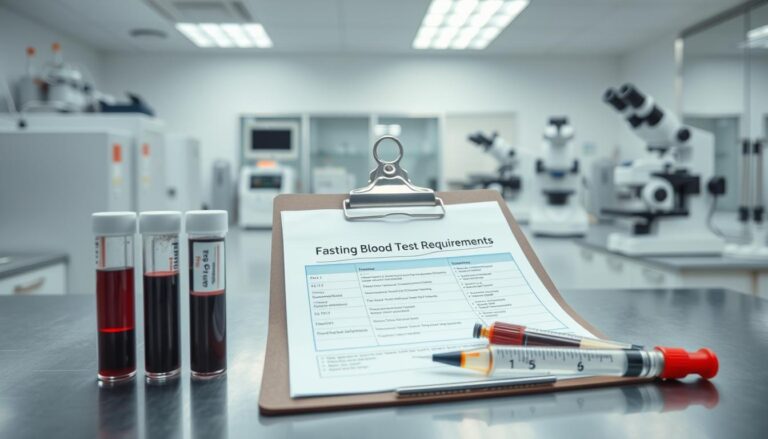Understanding Your Cholesterol Test Results: Complete Guide
We often get our cholesterol test results without knowing what they mean. Can you make sense of your cholesterol lab values to improve your health? We’ll cover the basics of cholesterol testing. This includes how to read your test results and understand them, to help you make informed choices.
Cholesterol test numbers can be hard to understand, but with the right info, it gets easier. Our guide will show you how to interpret your cholesterol levels. This includes looking at cholesterol blood test result time to help you grasp your health better.

Learning to interpret your cholesterol levels and understanding its components, like total cholesterol, helps manage your health. We’ll give you a detailed look at cholesterol test results. This includes how to read and understand them, to help you start a healthier lifestyle.
The Basics of Cholesterol Testing and Why It Matters
Cholesterol testing is key to keeping us healthy. It shows us our health status and warns us of risks. We talk about cholesterol types like LDL and HDL, which are important for our health.
Knowing what our cholesterol numbers mean is important. A test shows total cholesterol, LDL, HDL, and triglycerides. This helps us understand our cholesterol levels and how to keep them balanced.
Cholesterol ratio interpretation is also crucial. It tells us our risk of heart disease and other health problems.
Here are some key points to consider when it comes to cholesterol testing:
- Cholesterol screening numbers are used to assess our risk of heart disease
- LDL and HDL levels explained in the context of cholesterol ratio interpretation help us understand our overall health
- Understanding cholesterol levels is crucial for taking preventive measures
- Interpreting cholesterol numbers requires considering multiple factors, including age, gender, and family history
Breaking Down Your Cholesterol Test Numbers Explained
Understanding your cholesterol test results is key. It’s important to know the different parts of the cholesterol panel. This includes total cholesterol, HDL, LDL, and triglycerides. By looking at these numbers, you can understand your cholesterol levels and their impact on your health.
To start, let’s explore the different parts of the cholesterol test and what they mean.
Total Cholesterol: What the Numbers Mean
Total cholesterol is the total amount of cholesterol in your blood. It includes both HDL and LDL. A high total cholesterol level can raise your risk of heart disease.
HDL: The “Good” Cholesterol Levels
HDL, or “good” cholesterol, helps remove other cholesterol from your blood. High HDL levels can lower your risk of heart disease.
Here is a table to help you understand the cholesterol range explained:
| Component | Desirable Level | Borderline Level | High Level |
|---|---|---|---|
| Total Cholesterol | Less than 200 mg/dL | 200-239 mg/dL | 240 mg/dL or higher |
| HDL | 60 mg/dL or higher | 40-59 mg/dL | Less than 40 mg/dL |
| LDL | Less than 100 mg/dL | 100-129 mg/dL | 130 mg/dL or higher |
| Triglycerides | Less than 150 mg/dL | 150-199 mg/dL | 200 mg/dL or higher |
By understanding your cholesterol lab values and interpreting test numbers, you can start to keep your cholesterol levels healthy. This can help reduce your risk of heart disease.
How to Interpret Your Cholesterol Levels
Understanding your cholesterol test results can seem hard. But knowing the different parts of the test is key to keeping your cholesterol healthy. It’s important to look at how different factors affect your ldl and hdl levels. We’ll explain how to read your cholesterol levels, including ratios and guidelines based on age and gender.
A cholesterol test is a blood test that checks your cholesterol types. It shows your total cholesterol, ldl, hdl, and triglycerides. To find your best cholesterol levels, compare your test results to the healthy ranges.
Understanding Cholesterol Ratios
Cholesterol ratios are key to understanding your test results. The total cholesterol to hdl ratio shows your heart disease risk. A lower ratio means less risk, while a higher ratio means more risk. We’ll show you how to calculate this ratio and what it means for your health.
Age and Gender-Specific Guidelines
Age and gender affect your cholesterol levels. Women usually have higher hdl levels, while men have higher ldl levels. Knowing these guidelines helps you understand your test results and find your best cholesterol levels.
| Age | Gender | Optimal Cholesterol Levels |
|---|---|---|
| 20-39 | Male | Less than 130 mg/dL |
| 20-39 | Female | Less than 130 mg/dL |
| 40-59 | Male | Less than 130 mg/dL |
| 40-59 | Female | Less than 130 mg/dL |
Conclusion: Taking Action Based on Your Results
Now that you know your cholesterol test numbers, it’s time to act. Keeping your cholesterol levels healthy is key for your well-being. High or low cholesterol can raise your risk of heart disease and other health issues.
Work with your healthcare provider to create a plan to improve your cholesterol. Whether your numbers are good or need work, regular tests are crucial. Follow the guidelines for your age and risk factors to keep your heart healthy.
Changing your lifestyle can help a lot. Eating right, exercising, and managing stress can support healthy cholesterol. If your doctor suggests medication, take it as directed. By controlling your cholesterol, you can make better health choices and stay healthy.







